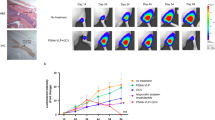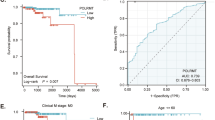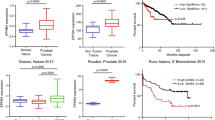Abstract
A novel gene, pHyde, was recently cloned from Dunning rat prostate cancer cells. A recombinant adenovirus containing pHyde cDNA gene (AdpHyde) was generated to investigate the biological function of pHyde protein. AdpHyde inhibited the growth of human prostate cancer cells. Apoptosis was induced in AdpHyde transduced cells as demonstrated by DAPI (4′, 6-diamino-2-phenylindole), TUNEL (terminal deoxynucleotidyl transferase-mediated dUTP nick and labeling) staining, and flow cytometry assays. Apoptosis was also induced in human xenograft prostate cancer tumors growing in nude mice following treatment with AdpHyde. AdpHyde transduction resulted in a dose-dependent stimulation of caspase-3 activity in DU145 cells which was blocked by DEVD (succinyl-Asp-Glu-Val-Asp-aldehyde) and VAD (benzyloxycarbonyl - Val - Ala - Asp -fluoromethylketone), inhibitors specifically against caspase-3. Moreover, cancer cells that lacked expression of endogenous caspase-3 were not or barely inhibited by pHyde. These results taken together suggest that pHyde inhibits cancer growth by inducing apoptosis through a caspase-3 dependent pathway.
This is a preview of subscription content, access via your institution
Access options
Subscribe to this journal
Receive 50 print issues and online access
$259.00 per year
only $5.18 per issue
Buy this article
- Purchase on Springer Link
- Instant access to full article PDF
Prices may be subject to local taxes which are calculated during checkout









Similar content being viewed by others
References
Buckley CD, Pilling D, Henriguez NV, Parsonage G, Threlfall K, Scheel-Toellner D, Simmons DL, Akbar AN, Lord JM, Salmon M . 1999 Nature 397: 534–539
Carter BH, Piantadosi S, Isaacs JT . 1990 J. Urol. 143: 742–746
Chang H, Yang X . 2000 Microbiol. Mol. Biol. Rev. 64: 821–846
Cohen GM . 1997 Biochem. J. 326: 1–16
Duan H, Chinnaiyan AM, Hudson PL, Wing JP, He W-W, Dixit VM . 1996 J. Biol. Chem. 271: 1621–1625
Enari M, Sakahira H, Yokoyama H, Okawa K, Iwamatsu A, Nagata S . 1998 Nature 391: 43–50
El-Etreby MF, Liang Y, Wrenn RW, Schoenlein PV . 1998 Breast Cancer Res. Treat 51: 149–168
Graham FL, Prevec L . 1991 Methods in Molecular Biology Murray EJ (ed.) Human Press Inc Chapter 11 pp 109–128
Greenlee RT, Hill-Harmon MB, Murray T, Thun M . 2001 CA Cancer J. Clin. 51: 15–36
Hyer ML, Rubinchik S, Dong J-Y, Voelkel-Johnson C, Gunhan M, Norris JS . 2000 Mol. Ther. 1: S322
Jackman J, O'Connor PM . 1998 Current Protocols in Cell Biology. Bonifacino JS, Dasso M, Harford JB . Lippincott-Schwartz and Yamada KM (eds.) John Wiley & Sons, Inc pp 8.3.1–8.3.16
Janicke RU, Walker PA, Lin XY, Porter AG . 1996 EMBO J. 15: 6969–6978
Janicke RU, Sprengart ML, Wati MR, Porter AG . 1998 J. Biol. Chem. 273: 9357–9360
Kadkol SS, Brody JR, Epstein JI, Kuhajda FP, Pasternack GR . 1998 Prostate 34: 231–237
Li F, Srinivasan A, Wang Y, Armstrong RC, Tomaselli KJ, Fritz LC . 1997 J. Biol. Chem. 272: 30299–30305
Liu X, Zou H, Slaughter C, Wang X . 1997 Cell 89: 175–184
Lu Y, Whitaker L, Li X, Lotan D, Lotan R . 1995 Mol. Cell. Differ. 3: 175–191
Lu Y, Carraher J, Zhang Y, Armstrong J, Lerner J, Roger W, Steiner MS . 1999 Cancer Gene Ther. 6: 64–72
Mantzoros CS, Tzonou A, Signorello LB, Stampfer M, Trichopoulos D, Adami H-O . 1997 Br. J. Cancer 76: 1115–1118
Nicholson DW, Thornberry NA . 1997 Trends Biochem. Sci. 22: 299–306
Oberhammer F, Wilson JW, Dive C, Morris ID, Hickman JA, Wakeling AE, Walker PR, Sikorska M . 1993 EMBO J. 12: 3679–3684
Okuma E, Saeki K, Shimura M, Ishizaka Y, Yasug E, You A . 2000 Leukemia 14: 612–619
Oridate N, Lotan D, Xu X-C, Hong WK, Lotan R . 1996 Clin. Cancer Res. 2: 855–863
Porter AG, Ng P, Janicke RU . 1997 BioEssays 19: 501–507
Rinaldy A, Steiner MS . 1999 DNA Cell Biol. 18: 829–836
Rokhlin OW, Bishop GA, Hostager BS, Waldschmidt TJ, Sidorenko SP, Pavloff N, Kiefer MC, Umansky SR, Glover RA, Cohen MB . 1997 Cancer Res. 57: 1758–1768
Sakahira H, Enari M, Nagata S . 1998 Nature 391: 96–99
Sandberg AA . 1992 Hum. Pathol. 23: 368–380
Schulze-Osthoff K, Walczak H, Droge W, Krammer PH . 1994 J. Cell. Biol. 127: 15–20
Steiner MS, Zhang X, Wang Y, Lu Y . 2000 Cancer Res. 60: 4419–4425
Stennicke HR, Salvesen GS . 1998 Biochim. Biophys. Acta. 1387: 17–31
Stennicke HR, Jurgensmeier JM, Shin H, Deveraux Q, Wolf BB, Yang X, Zhou Q, Ellerby HM, Ellerby LM, Bredesen D, Green DR, Reed JC, Froelich CJ, Salvesen GS . 1998 J. Biol. Chem. 273: 27084–27090
Talanian RV, Yang X, Turbov J, Seth P, Ghayur T, Casiano CA, Orth K, Froelich CJ . 1997 J. Exp. Med. 186: 1323–1331
Tewari M, Quan LT, O'Rourke K, desnoyers S, Zeng Z, Beidler DR, Poirier GG, Salvesen GS, Dixit VM . 1995 Cell. 81: 801–809
Thornberry NA, Bull HG, Calaycay JR, Chapman KT, Howard AD, Kostura MJ, Miller DK, Molineaux SM, Weidner JR, Aunins J, Elliston KO, Ayala JM, Casano FJ, Chin J, Ding GJ-F, Egger LA, Gaffney EP, Limjuco G, Palyha OC, Raju SM, Rolando AM, Salley JP, Yamin TT, Lee TD, Shively JE, MacCross M, Mumford RA, Schmidt JA, Tocci MJ . 1992 Nature 356: 768–774
Tseng CP, Ely BD, Li Y, Pong RC, Hsieh JT . 1998 Endocrinol. 139: 3542–3553
Ucker DS, Obermiller PS, Eckhart W, Apgar JR, Berger NA, Meyers J . 1992 Mol. Cell. Biol. 12: 3060–3069
Wolk A, Mantzoros CS, Andersson S-O, Bergstrom R, Signorello LB, Lagiou P, Adami HO, Trichopoulos D . 1998 J. Natl. Cancer Inst. 90: 876–879
Yang X, Stennicke HR, Wang B, Green DR, Janicke RU, Srinicasan A, Seth P, Salvesen GS, Froelich CJ . 1998 J. Biol. Chem. 273: 34278–34283
Zhang XW, Qing C, Xu B . 1999 Anticancer Drugs 10: 569–576
Acknowledgements
This research was supported in part by University of Tennessee Medical Group Morenton Oncology Research Grant and American Cancer Society Grant #IRG-87-008-09, and in part by Assisi Foundation of Memphis and Hyde Family Foundation. The cost of publication was supported by University of Tennessee Vascular Biology Center of Excellence Partnership Grant.
Author information
Authors and Affiliations
Corresponding author
Rights and permissions
About this article
Cite this article
Zhang, X., Steiner, M., Rinaldy, A. et al. Apoptosis induction in prostate cancer cells by a novel gene product, pHyde, involves caspase-3. Oncogene 20, 5982–5990 (2001). https://doi.org/10.1038/sj.onc.1204831
Received:
Revised:
Accepted:
Published:
Issue Date:
DOI: https://doi.org/10.1038/sj.onc.1204831
Keywords
This article is cited by
-
Ibrutinib conjugated surface-functionalized multiwalled carbon nanotubes and its biopolymer composites for targeting prostate carcinoma
Journal of Materials Science (2021)
-
IgG silencing induces apoptosis and suppresses proliferation, migration and invasion in LNCaP prostate cancer cells
Cellular & Molecular Biology Letters (2016)
-
Identification of a ferrireductase required for efficient transferrin-dependent iron uptake in erythroid cells
Nature Genetics (2005)
-
ACRATA: a novel electron transfer domain associated to apoptosis and cancer
BMC Cancer (2004)



